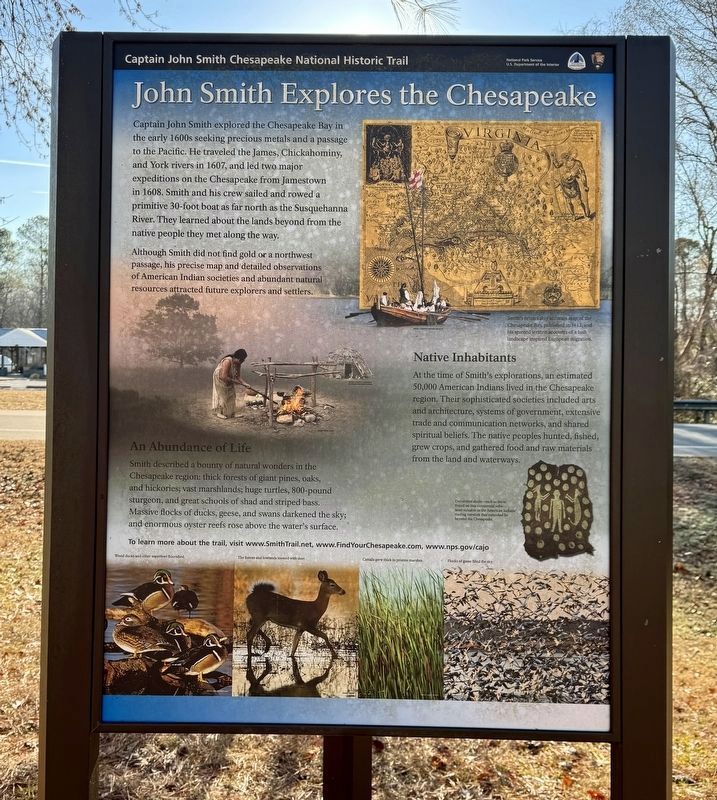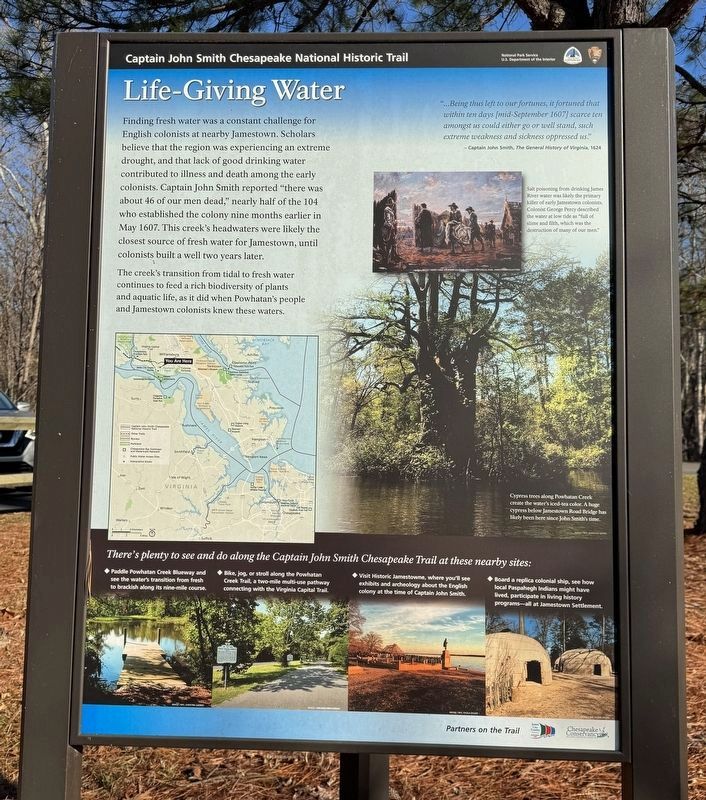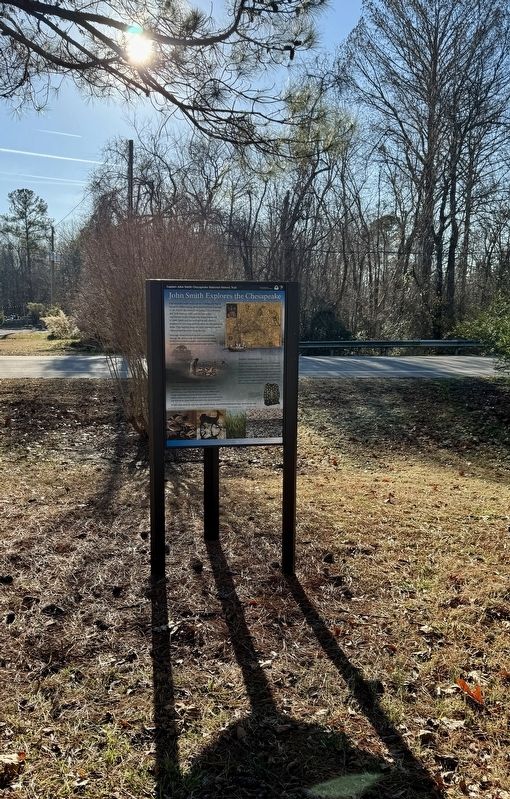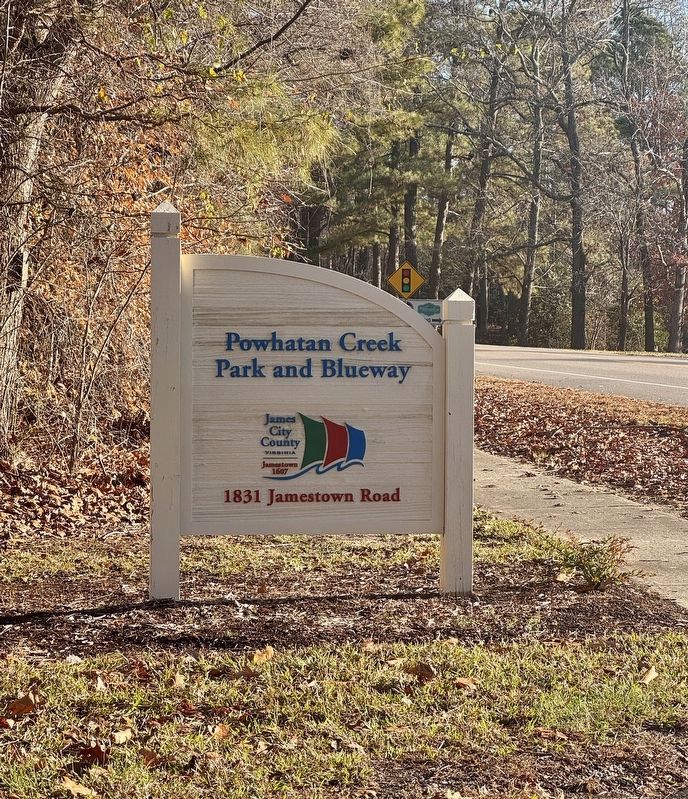Near Williamsburg in James City County, Virginia — The American South (Mid-Atlantic)
John Smith Explores the Chesapeake
Captain John Smith Chesapeake National Historic Trail
— National Park Service, U.S. Department of the Interior —
John Smith Explores the Chesapeake
Captain John Smith explored the Chesapeake Bay in the early 1600s seeking precious metals and a passage to the Pacific. He traveled the James, Chickahominy, and York rivers in 1607, and led two major expeditions on the Chesapeake from Jamestown in 1608. Smith and his crew sailed and rowed a primitive 30-foot boat as far north as the Susquehanna River. They learned about the lands beyond from the native people they met along the way.
Although Smith did not find gold or a northwest passage, his precise map and detailed observations of American Indian societies and abundant natural resources attracted future explorers and settlers.
Native Inhabitants
At the time of Smith’s explorations, an estimated 50,000 American Indians lived in the Chesapeake region. Their sophisticated societies included arts and architecture, systems of government, extensive trade and communication networks, and shared spiritual beliefs. The native peoples hunted, fished, grew crops, and gathered food and raw materials from the land and waterways.
An Abundance of Life
Smith described a bounty of natural wonders in the Chesapeake region: thick forests of giant pines, oaks, and hickories; vast marshlands; huge turtles, 800-pound sturgeon, and great schools of shad and striped bass.
Massive flocks of ducks, geese, and swans darkened the sky; and enormous oyster reefs rose above the water's surface.
To learn more about the trail visit www.smithtrail.net
[Captions:]
Smith’s remarkably accurate map of the Chesapeake Bay, published in 1612, and his spirited written accounts of a lush landscape inspired European migration.
Decorative shells — such as those found on this ceremonial robe — were valuable in the American Indians’ trading network that extended far beyond the Chesapeake.
Wood ducks and other waterfowl flourished
The forests and lowlands teemed with deer
Cattails grew thick in pristine marshes
Flocks of geese filled the sky
Life-Giving Water
Finding fresh water was a constant challenge for English colonists at nearby Jamestown. Scholars believe that the region was experiencing an extreme drought, and that lack of good drinking water contributed to illness and death among the early colonists. Captain John Smith reported "there was about 46 of our men dead, nearly half of the 104 who established the colony nine months earlier in May 1607. This creek's headwaters were likely the closest source of fresh water for Jamestown, until colonists built a well two years later.
The creek's transition from tidal to fresh water continues to feed a rich biodiversity of plants and aquatic life, as it did when Powhatan's people and Jamestown colonists knew these waters.
“… Being thus left to our fortunes, it fortuned that within ten days [mid-September 1607] scarce ten amongst us could either go or well stand, such extreme weakness and sickness oppressed us.”
— Captain John Smith, The General History of Virginia, 1624
[Sidebar:]
There’s plenty to see and do along the Captain John John Smith Chesapeake Trail at these nearby sites:
♦ Paddle Powhatan Creek Blueway and see the water's transition from fresh to brackish along its nine-mile course.
♦ Bike, jog, or stroll along the Powhatan Creek Trail, a two-mile multi-use pathway connecting with the Virginia Capital Trail.
♦ Visit Historic Jamestowne, where you'll see exhibits and archeology about the English colony at the time of Captain John Smith.
♦ Board a replica colonial ship, see how local Paspahegh Indians might have lived, participate in living history programs- all at Jamestown Settlement.
[Captions:]
Salt poisoning from drinking James River water was likely the primary killer of early Jamestown colonists. Colonist George Percy described the water at low tide as "full of slime and filth, which was the destruction of many of our men.”
Cypress trees along Powhatan Creek create the water's iced-tea color. A huge cypress below Jamestown Road Bridge has likely been here since John Smith's time.
Erected by National Park Service, U.S. Department of the Interior.
Topics. This historical marker is listed in these topic lists: Colonial Era • Exploration • Native Americans • Settlements & Settlers. A significant historical year for this entry is 1607.
Location. 37° 14.274′ N, 76° 46.056′ W. Marker is near Williamsburg, Virginia, in James City County. Marker is on Jamestown Road (Virginia Route 5) 0.3 miles west of Sandy Bay Road, on the right when traveling west. The marker is located in the parking area of the Powhatan Creek Park and Blueway. Touch for map. Marker is at or near this postal address: 1831 Jamestown Road, Williamsburg VA 23185, United States of America. Touch for directions.
Other nearby markers. At least 8 other markers are within walking distance of this marker. Church On The Main (approx. 0.4 miles away); a different marker also named Church On The Main (approx. 0.4 miles away); a different marker also named Church On The Main (approx. 0.4 miles away); Battle of Green Spring Memorial (approx. 0.4 miles away); Samuel H. Yonge, Civil Engineer (1843-1935) (approx. 0.9 miles away); Pocahontas (approx. 0.9 miles away); Jamestown Road (approx. 0.9 miles away); First Germans at Jamestown (approx. 0.9 miles away). Touch for a list and map of all markers in Williamsburg.
Also see . . . John Smith’s Exploration Routes in the Chesapeake Bay. (Submitted on December 23, 2023, by Brandon D Cross of Flagler Beach, Florida.)
Credits. This page was last revised on December 23, 2023. It was originally submitted on December 23, 2023, by Brandon D Cross of Flagler Beach, Florida. This page has been viewed 56 times since then and 27 times this year. Photos: 1, 2, 3, 4. submitted on December 23, 2023, by Brandon D Cross of Flagler Beach, Florida. • Devry Becker Jones was the editor who published this page.



